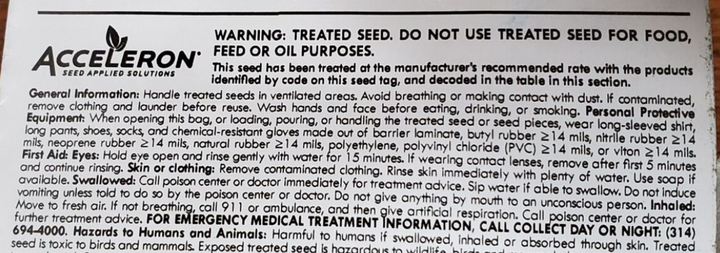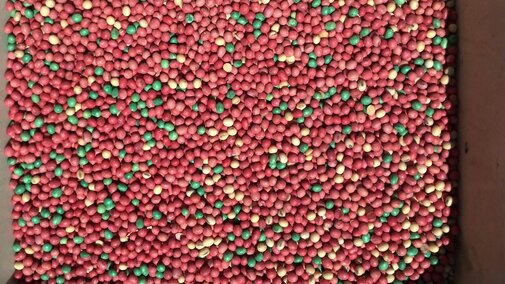Checking labels has become second nature, but what about checking the seed tag? This year remember to be safe when handling treated seed and check the seed tag for specific handling and use directions.
Treated seed is another route of exposure for the handler when thinking about pesticide safety; whether this exposure is to fungicide, insecticide, or nematicide treatments present on treated seed. Remember that reducing our exposure is key to reducing the overall risk when handling pesticides. Below are tips to safely handle treated seed, remember to read and follow all label directions.
- Read the seed tag. This will be key to identifying personal protective equipment PPE requirements, signal words, use, disposal, environmental hazards, and storage information. Also be familiar with any restrictions (plant back or grazing) listed on the tag, before use.
- Wear the right PPE. Most seed tags at minimum require long pants, long sleeves, shoes, socks, and chemical resistant gloves to handle the product.
Along with wearing PPE and reviewing the seed tag, choosing the right chemical resistant gloves is key to safe handling. Unlined chemical resistant gloves that cover the forearm provide protection over a greater area and reduce the risk of exposure. Cotton lined gloves, while more comfortable, absorb pesticides, are hard to clean, and increase your risk of exposure. Many seed treatments require wearing gloves that have 14-mil (0.001 inch) thickness or greater when handling treated seed. These gloves can be made out of a variety of materials and are categorized by the EPA by their chemical resistance.
Chemical resistance categories (designated A-H) may be listed on the pesticide label and are based on the solvent rather than the actual pesticides. These categories describe the time you can safely handle a product using the material and thickness of different gloves. Many seed tags will list the EPA chemical resistance category or simply list the glove requirements directly on the seed tag. More information can be obtained by downloading the current label from the seed treatment provider. Looking at the snapshot (Figure 1) of the seed tag for Acceleron®, under the PPE section of the label we will find the type of chemical resistant gloves that meet label requirements.

When handling treated seed this planting season be safe, reduce exposure, and always wear your PPE. In the event of a spill of treated seed, cover or dispose of the product following label instructions. Review the first aid before using the product and have a gallon of clean water with you to wash reusable gloves before removing them. After the gloves have been removed, remember to wash your hands with soap and water. Lastly, remember to inspect your PPE and replace items that are worn out or no longer effective. Have a safe planting season and for information on glove selection see NebGuide G1961, Pesticide Safety: Choosing the Right Gloves.
Products listed are for educational purposes and do not constitute an endorsement or recommendation.

